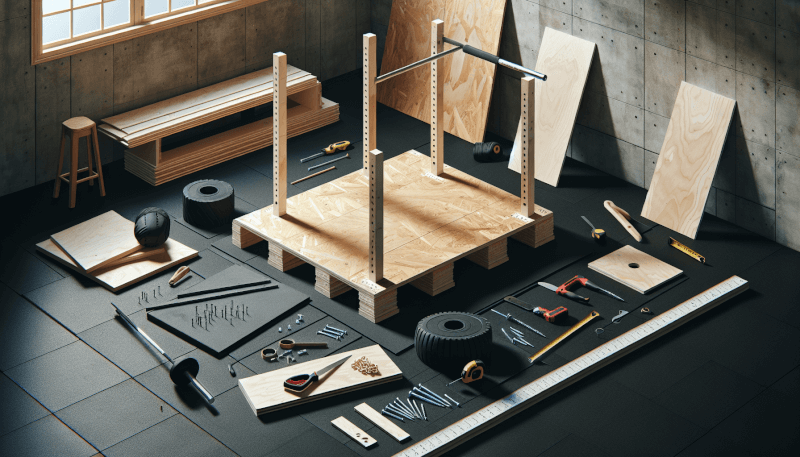If you’re looking to elevate your weightlifting routine without breaking the bank, building your own DIY weightlifting platform for your home gym is the perfect solution. This article will guide you through the step-by-step process of creating a sturdy and durable platform that will not only protect your floors but also provide a solid foundation for your weightlifting exercises. Whether you’re a beginner or an experienced lifter, this project is both budget-friendly and customizable, allowing you to achieve your fitness goals in the comfort of your own home.

Choosing the Right Space
When it comes to building a DIY weightlifting platform for your home gym, the first step is to choose the right space. You need to determine the available space in your home and find a suitable area where you can set up your weightlifting platform. Consider factors such as the size of the room and the layout of your home gym.
Another important consideration is the ceiling height. Make sure there is enough clearance above the area where you will be lifting weights. This is crucial to ensure that you can safely perform exercises like overhead presses without hitting the ceiling.
Lastly, consider the flooring in the chosen space. Ideally, you want a solid and level surface that can support the weight of the platform and withstand the impact of heavy weights being dropped. If your existing flooring is not suitable, you may need to invest in rubber flooring or mats to provide the necessary protection.
Gathering Materials and Tools
Before you can start building your weightlifting platform, you’ll need to gather all the necessary materials and tools. Here is a list of the required materials:
- Plywood: You will need a large piece of plywood that meets the dimensions you have determined for your platform.
- Frame pieces: These will be used to create the frame of the platform. You can use dimensional lumber or other suitable materials.
- Support beams: These beams will provide additional stability to the platform.
- Rubber mat: This will be attached to the platform to create a durable and impact-absorbing surface.
- Screws: You will need screws to secure the various components of the platform.
- Sandpaper: This will be used to smooth the surface of the platform before applying a protective finish.
In terms of tools, you’ll need the following:
- Measuring tape: This will be used to measure the dimensions of the platform components accurately.
- Circular saw or table saw: You will use this to cut the plywood and frame pieces to the desired lengths.
- Drill: This will be used to attach the various components together with screws.
- Screwdriver: You’ll need a screwdriver to tighten the screws securely.
- Sander: This will be used to sand the surface of the platform.
Make sure you have all the required materials and tools before you begin the construction process. This will ensure a smooth and efficient DIY experience.
Measuring and Cutting Plywood
Once you have gathered all the necessary materials and tools, it’s time to measure and cut the plywood for your weightlifting platform. Start by measuring the dimensions of the area where the platform will be placed. Take accurate measurements to ensure a perfect fit.
Using a circular saw or table saw, cut the plywood according to the dimensions you have measured. Make sure to follow the marked lines and cut straight to achieve clean and precise cuts. Take your time and double-check your measurements to avoid any potential errors.
Preparing the Frame
With the plywood cut to size, it’s time to prepare the frame for your weightlifting platform. Start by measuring and cutting the frame pieces that will surround the plywood. The frame will provide stability and support to the platform.
Measure the length and width of the plywood and cut the frame pieces accordingly. Make sure to account for the thickness of the plywood when measuring the lengths of the frame pieces. Once the frame pieces are cut, assemble them using screws to create the frame structure.
To ensure a sturdy frame, make sure the corners are securely connected, and the frame is square. This will provide a solid base for attaching the plywood and creating the platform.

Building the Platform Base
Now that you have the plywood cut and the frame prepared, it’s time to attach the plywood to the frame and build the platform base. Place the plywood on top of the frame, ensuring that it fits seamlessly within the frame’s boundaries.
To secure the plywood to the frame, use screws around the edges of the plywood. Make sure to space the screws evenly and drive them through the plywood and into the frame. This will ensure a secure attachment that can withstand the weight and impact of heavy weights.
To further reinforce the corners and edges of the platform, add additional screws along these areas. This will prevent any potential lifting or shifting of the plywood during use.
Adding the Center Support
To enhance the stability of your weightlifting platform, it’s crucial to add a center support beam. This support beam will provide additional strength and prevent any sagging or flexing of the platform.
Measure and cut the support beams to match the width of your weightlifting platform. Attach these beams horizontally to the underside of the plywood, using screws. Make sure the beams are evenly spaced along the length of the platform and securely fastened.
By adding a center support beam, you ensure that the weightlifting platform can handle heavy loads and distribute the weight effectively.

Finishing Touches
Once the platform base is complete, it’s time to add some finishing touches to enhance its durability and longevity. Start by sanding the surface of the platform using sandpaper. This will smooth out any uneven areas or rough edges, creating a comfortable and safe lifting surface.
After sanding, it’s recommended to apply a protective finish to the platform. This can be a polyurethane or lacquer sealant that will protect the plywood from moisture, scratches, and wear. Follow the manufacturer’s instructions for applying the protective finish, and allow it to dry completely before using the platform.
By adding these finishing touches, you ensure that your weightlifting platform not only performs well but also stands the test of time.
Installing the Rubber Mat
To further enhance the safety and performance of your weightlifting platform, it’s beneficial to install a rubber mat on top. The rubber mat will provide increased impact absorption, preventing damage to your equipment and floors.
Measure and cut the rubber mat to match the dimensions of your weightlifting platform. It should seamlessly fit on top of the plywood surface. Attach the rubber mat to the platform using adhesive or double-sided tape, ensuring it is securely fixed in place.
The rubber mat will provide a non-slip surface, minimize noise, and add an extra layer of protection to your weightlifting platform.

Testing the Stability
Before you start using your newly constructed weightlifting platform, it’s essential to test its stability. Check for any signs of wobbling or shifting by performing a few light test lifts.
If you notice any instability, carefully examine the platform for any loose screws or connections. Make necessary adjustments to tighten any loose components and ensure the stability of the platform.
By thoroughly testing the stability of your weightlifting platform, you can have peace of mind knowing it is safe and secure for your weightlifting routines.
Organizing and Using Your Weightlifting Platform
Now that your weightlifting platform is fully constructed and stable, it’s time to organize your home gym and start using it for your weightlifting routines.
Arrange your other gym equipment, such as weight benches, barbells, and dumbbells, around the weightlifting platform. Make sure there is clear and safe access to all the necessary equipment.
When performing your weightlifting routine, use proper form and technique to ensure your safety and maximize your workout effectiveness. Gradually increase the weights as you progress and always listen to your body to prevent any potential injuries.
Remember to maintain regular cleaning and maintenance of your weightlifting platform to keep it in optimal condition. Regularly inspect the screws and connections, and tighten them if necessary. Clean the surface and rubber mat regularly to remove any dirt or debris.
By following these steps and taking care of your weightlifting platform, you can enjoy a safe and effective workout experience in the comfort of your home gym. Happy lifting!



